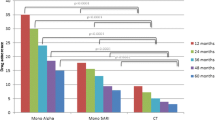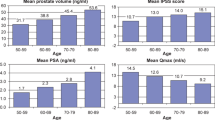Abstract
Purpose
We aimed to describe, in a daily clinical practice setting, the demographic and comorbidity profile of patients with lower urinary tract symptoms suggestive of benign prostatic hyperplasia (BPH-LUTS), to compare the characteristics of patients receiving 5-alpha-reductase inhibitors (5-ARIs) with those not receiving them and to investigate predictors of 5-ARI prescription.
Methods
We performed a retrospective observational study using data retrieved from a general practitioners database. Male patients with diagnosis of BPH-LUTS were included. The following demographic and clinical data were available and extracted: age, comorbidities, BPH-LUTS medical therapy, drugs for comorbidities. A subgroup analysis was performed according to the use of 5-ARIs. Factors associated with 5-ARI prescription were assessed with uni- and multivariate analyses.
Results
A total of 7,103 patients were identified. Most patients (71.7 %) were aged ≥65 years. Hypertension was present in 64.9 % of patients; it was the most prevalent comorbidity followed by diabetes mellitus, hypercholesterolemia, coronary artery disease and other dyslipidemias. Overall, 38.22 % of patients were treated with 5-ARIs. Mean age of patients taking 5-ARIs was significantly higher. The prevalence of hypertension and the use of antihypertensive drugs were significantly higher among patients receiving 5-ARIs. Older age was an independent predictor of 5-ARI prescription.
Conclusions
In a daily clinical practice setting, patients with BPH-LUTS receiving 5-ARIs are significantly older and have significantly higher prevalence of hypertension if compared with patients with BPH-LUTS not receiving 5-ARIs. Older age is an independent predictor of 5-ARI prescription.
Similar content being viewed by others
References
Verhamme KM, Dieleman JP, Bleumink GS, van der Lei J, Sturkenboom MC, Artibani W, Begaud B, Berges R, Borkowski A, Chappel CR, Costello A, Dobronski P, Farmer RD, Jiménez Cruz F, Jonas U, MacRae K, Pientka L, Rutten FF, van Schayck CP, Speakman MJ, Sturkenboom MC, Tiellac P, Tubaro A, Vallencien G, Vela Navarrete R (2002) Triumph Pan European Expert Panel. Incidence and prevalence of lower urinary tract symptoms suggestive of benign prostatic hyperplasia in primary care—the Triumph project. Eur Urol 42(4):323–328
AUA practice guidelines committee (2003) AUA guideline on management of benign prostatic hyperplasia. Chapter 1: diagnosis and treatment recommendations. J Urol 170:530–547
Oelke M, Bachmann A, Descazeaud A, Emberton M, Gravas S, Michel MC, N’Dow J, Nordling J, de la Rosette JJ, European Association of Urology (2013) EAU guidelines on the treatment and follow-up of non-neurogenic male lower urinary tract symptoms including benign prostatic obstruction. Eur Urol 64(1):118–140
Roehrborn CG, Siami P, Barkin J, Damião R, Major-Walker K, Nandy I, Morrill BB, Gagnier RP, Montorsi F, CombAT Study Group (2010) The effects of combination therapy with dutasteride and tamsulosin on clinical outcomes in men with symptomatic benign prostatic hyperplasia: 4-year results from the CombAT study. Eur Urol 57(1):123–131
Erdemir F, Harbin A, Hellstrom WJ (2008) 5-Alpha reductase inhibitors and erectile dysfunction: the connection. J Sex Med 5(12):2917–2924
Gur S, Kadowitz PJ, Hellstrom WJ (2013) Effects of 5-alpha reductase inhibitors on erectile function, sexual desire and ejaculation. Expert Opin Drug Saf 12(1):81–90
Seftel A, Rosen R, Kuritzky L (2007) Physician perceptions of sexual dysfunction related to benign prostatic hyperplasia (BPH) symptoms and sexual side effects related to BPH medications. Int J Impot Res 19(4):386–392
Burnett AL (2006) The role of nitric oxide in erectile dysfunction: implications for medical therapy. J Clin Hypertens 8:53–62
Napalkov P, Maisonneuve P, Boyle P (1995) Worldwide patterns of prevalence and mortality from benign prostatic hyperplasia. Urology 46:41–46
McConnell JD, Roehrborn CG, Bautista OM, Andriole GL Jr, Dixon CM, Kusek JW, Lepor H, McVary KT, Nyberg LM Jr, Clarke HS, Crawford ED, Diokno A, Foley JP, Foster HE, Jacobs SC, Kaplan SA, Kreder KJ, Lieber MM, Lucia MS, Miller GJ, Menon M, Milam DF, Ramsdell JW, Schenkman NS, Slawin KM, Smith JA, Medical Therapy of Prostatic Symptoms (MTOPS) Research Group (2003) The long-term effect of doxazosin, finasteride, and combination therapy on the clinical progression of benign prostatic hyperplasia. N Engl J Med 349(25):2387–2398
McVary KT (2006) BPH: epidemiology and comorbidities. Am J Manag Care 12(5 Suppl):S122–S128
Sarma AV, Kellogg Parsons J (2009) Diabetes and benign prostatic hyperplasia: emerging clinical connections. Curr Urol Rep 10(4):267–275
Stamatiou K, Lardas M, Kostakos E, Koutsonasios V, Michail E (2009) The impact of diabetes type 2 in the pathogenesis of benign prostatic hyperplasia: a review. Adv Urol 1–3. doi:10.1155/2009/818965
Lekili M, Müezzinoğlu T, Uyanik BS, Büyüksu C (2006) Serum lipid levels in benign prostatic hyperplasia. World J Urol 24(2):210–213
Andriole GL, Kirby R (2003) Safety and tolerability of the dual 5-alpha-reductase inhibitor dutasteride in the treatment of benign prostatic hyperplasia. Eur Urol 44:82–88
Conflict of interest
The authors declare that they have no conflict of interest.
Ethical standard
This study was approved by the ethics committee and was performed in accordance with the ethical standards laid down in the 1964 Declaration of Helsinki and its later amendments.
Informed consent
All participants gave their informed consent prior to their inclusion in the study.
Author information
Authors and Affiliations
Corresponding author
Rights and permissions
About this article
Cite this article
Fusco, F., Arcaniolo, D., Creta, M. et al. Demographic and comorbidity profile of patients with lower urinary tract symptoms suggestive of benign prostatic hyperplasia in a real-life clinical setting: Are 5-alpha-reductase inhibitor consumers different?. World J Urol 33, 685–689 (2015). https://doi.org/10.1007/s00345-014-1460-9
Received:
Accepted:
Published:
Issue Date:
DOI: https://doi.org/10.1007/s00345-014-1460-9




